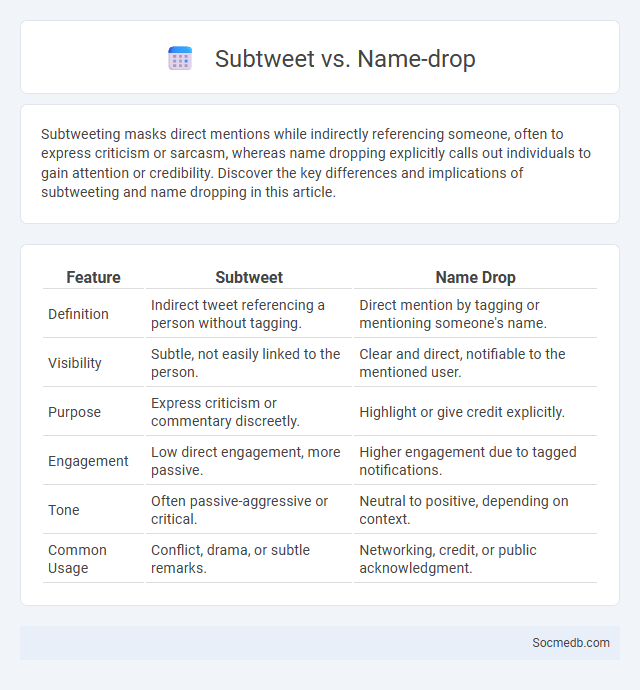
Photo illustration: Subtweet vs Name Drop
Subtweeting masks direct mentions while indirectly referencing someone, often to express criticism or sarcasm, whereas name dropping explicitly calls out individuals to gain attention or credibility. Discover the key differences and implications of subtweeting and name dropping in this article.
Table of Comparison
| Feature | Subtweet | Name Drop |
|---|---|---|
| Definition | Indirect tweet referencing a person without tagging. | Direct mention by tagging or mentioning someone's name. |
| Visibility | Subtle, not easily linked to the person. | Clear and direct, notifiable to the mentioned user. |
| Purpose | Express criticism or commentary discreetly. | Highlight or give credit explicitly. |
| Engagement | Low direct engagement, more passive. | Higher engagement due to tagged notifications. |
| Tone | Often passive-aggressive or critical. | Neutral to positive, depending on context. |
| Common Usage | Conflict, drama, or subtle remarks. | Networking, credit, or public acknowledgment. |
Understanding Subtweeting: Definition and Origins
Subtweeting involves posting indirect or veiled messages on social media platforms, often without directly mentioning the person or topic concerned. Originating from Twitter, this practice has evolved as users leverage subtweets to express opinions or conflicts discreetly, influencing online communication dynamics and social interactions. Understanding subtweeting helps you navigate and interpret nuanced online conversations more effectively.
What is Name Drop?: Meaning and Context
Name dropping is the act of mentioning a famous or influential person's name in conversation or on social media to impress others or establish credibility. On platforms like Instagram, Twitter, and LinkedIn, name drop can signal associations with well-known figures, enhancing your social status or professional network. Understanding the context and appropriate use of name dropping helps you avoid appearing boastful while subtly boosting your social influence.
Core Differences: Subtweet vs. Name Drop
Subtweeting involves posting indirect or veiled messages about someone without directly mentioning their name, often to express criticism or frustration privately but publicly visible to followers. Name dropping explicitly references the individual, making the message clear and direct, often used to gain attention or establish credibility. The core difference lies in subtweeting's ambiguity and subtlety versus name dropping's straightforward identification.
When to Use a Subtweet vs. a Name Drop
Using a subtweet is effective when you want to address behavior or issues indirectly without explicitly naming the person, maintaining a level of subtlety that can spark curiosity or reflection among your followers. Name dropping is best reserved for situations where direct acknowledgment or clear attribution is necessary, such as highlighting collaborations, giving credit, or addressing someone publicly to avoid misunderstandings. You should choose subtweets to engage your audience with nuanced hints, while name drops drive transparency and accountability in your social media interactions.
Subtweeting: Pros, Cons, and Best Practices
Subtweeting allows you to share indirect messages on social media, providing a way to express opinions without naming specific individuals, which can protect privacy but also lead to misunderstandings or conflicts. The pros include subtle communication and avoiding direct confrontation, while cons involve potential misinterpretation and fueling drama within your social network. To use subtweeting effectively, focus on clear intentions, avoid targeting specific people to reduce negativity, and consider how your audience might perceive your messages.
Name Dropping: Impact and Perception Online
Name dropping on social media significantly influences online perception by leveraging associations with well-known figures or brands to enhance credibility and social capital. This strategy can boost engagement and followers by creating a sense of exclusivity or endorsement, although it risks backlash if perceived as inauthentic or opportunistic. The impact varies across platforms, with Instagram and Twitter being particularly sensitive to name-dropping tactics due to their emphasis on personal branding and real-time interaction.
Subtweeting Revisited: Social Dynamics
Subtweeting Revisited: Social Dynamics explores the indirect communication patterns on social media platforms where users comment about others without direct mentions. Your online interactions reveal complex social hierarchies and subtle power plays through these ambiguous posts. Understanding these dynamics enhances your ability to navigate digital relationships and interpret underlying social cues.
Real-World Examples: Subtweeting and Name Dropping
Subtweeting involves indirectly referencing someone on social media without tagging them, often to express criticism or sarcasm, seen frequently on platforms like Twitter and Instagram. Name dropping occurs when users mention or tag well-known individuals to gain visibility or credibility, a tactic commonly used by influencers and brands to boost engagement. Both practices significantly impact online communication dynamics, shaping public perception and interaction patterns across social media networks.
Navigating Online Etiquette: Subtweets and Name Drops
Understanding online etiquette is crucial for maintaining a positive social media presence, especially when it comes to subtweets and name drops. Subtweets, indirect or vague references to someone without tagging them, can create confusion and foster negativity within your community. Use name drops thoughtfully by tagging individuals or brands directly to ensure clarity, respect, and constructive engagement in your conversations.
Choosing Your Approach: Subtweet or Name Drop?
Choosing your approach on social media depends on your goals and audience engagement; subtweeting allows for indirect communication that sparks curiosity without confrontation, ideal for subtlety and intrigue. Name dropping creates direct association, generating immediate attention and clear messaging, but risks backlash or perceived negativity. Your strategy should align with your content objectives, weighing the benefits of subtle influence against explicit calls for attention.
 socmedb.com
socmedb.com